by Eric Meier
When attempting to identify a wood sample, it’s important to keep in mind the limitations and obstacles that are present in our task. Before starting, please have a look at The Truth Behind Wood Identification to approach the task in a proper mindset; I consider the linked article to be required reading for all those visiting my site with the intent of identifying wood.
1. Confirm it is actually solid wood.
Before proceeding too much farther into the remaining steps, it’s first necessary to confirm that the material in question is actually a solid piece of wood, and not a man-made composite or piece of plastic made to imitate wood.
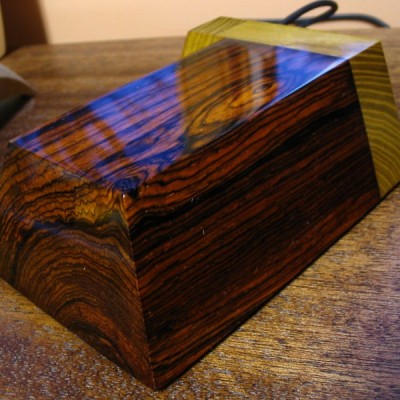
Can you see the end-grain?
Manufactured wood such as MDF, OSB, and particleboard all have a distinct look that is—in nearly all cases—easily distinguishable from the endgrain of real wood. Look for growth rings—formed by the yearly growth of a tree—which will be a dead-giveaway that the wood sample in question is a solid, genuine chunk of wood taken from a tree.
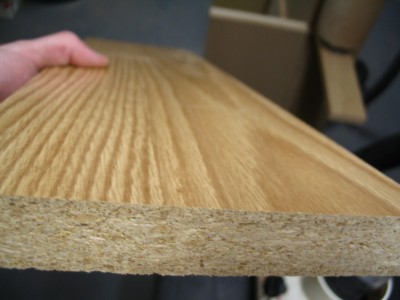
Is it veneered?
If you see a large panel that has a repeating grain pattern, it may be a veneer. In such cases, a very thin layer of real wood is peeled from a tree and attached to a substrate; sometimes the veneer can be one continuous repeating piece because it is rotary-sliced to shave off the veneer layer as the tree trunk is spun by machines. Assuming it is a real wood veneer with a distinct grain and texture—and not merely a piece of printed plastic—you may still be able to identify the outer veneer wood in question, but you should still realize that is it only a veneer and not a solid piece of wood.
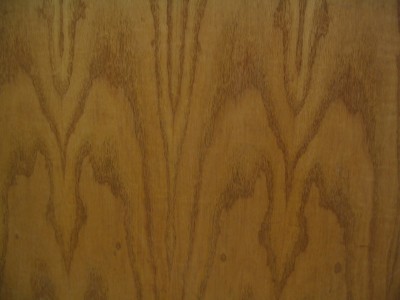
Is it painted or printed to look like wood?
Many times, especially on medium to large-sized flat panels for furniture, a piece of particleboard or MDF is either laminated with a piece of wood-colored plastic, or simply painted to look like wood grain. Many of today’s interior hardwood flooring planks are good examples of these pseudo-wood products: they are essentially a man-made material made of sawdust, glues, resins, and durable plastics.
2. Look at the color.
Some questions to immediately ask yourself:
Is the color of the wood natural, or is it stained?
If there is even a chance that the color isn’t natural, the odds are increased that the entire effort of identifying the wood will be in vain.
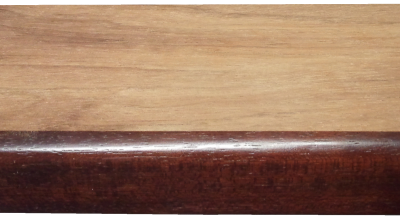
Is it weathered or have a patina?
Many woods, when left outside in the elements, tend to turn a bland gray color. Also, even interior wood also takes on a patina as it ages: some woods get darker, or redder, and some even get lighter or lose their color; but for the most part, wood tends to darken with age.
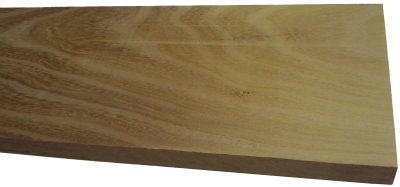
Is it possible to sand or plane the board to see the natural raw color of the wood?
The most predictable baseline to use when identifying wood is in a freshly sanded state. This eliminates the chances of a stain or natural aging skewing the color diagnosis of the wood.
3. Observe the wood grain.
If the wood is unfinished, then look at the texture of the grain. Ask yourself these questions:
Does the wood have an open, porous texture?
Most softwoods will be almost perfectly smooth with no grain indentations, while many common hardwoods have an open pore structure, such as oak or mahogany; though there are some hardwoods that are also smooth to the touch, such as maple.
Can you tell if the wood is quartersawn or plainsawn?
By observing the grain patterns, many times you can tell how the board was cut from the tree. Some wood species have dramatically different grain patterns from plainsawn to quartersawn surfaces. For instance, on their quartersawn surfaces, lacewood has large lace patterns, oak has flecks, and maple has the characteristic “butcher block” appearance.
Is there any figure or unusual characteristics, such as sapwood, curly or wild grain, burl/knots, etc.?
Some species of wood have figure that is much more common than in other species: for example, curly figure is fairly common in soft maple, and the curls are usually well-pronounced and close together. Yet when birch or cherry has a curly grain, it is more often much less pronounced, and the curls are spaced farther apart.
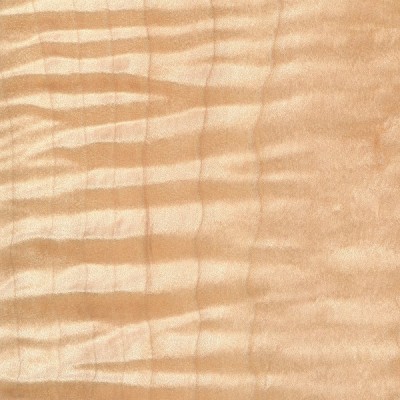
4. Consider the weight and hardness of the wood.
If it’s possible, pick the piece of wood up and get a sense of its weight, and compare it to other known wood species. Try gouging the edge with your fingernail to get a sense of its hardness. If you have a scale, you can take measurements of the length, width, and thickness of the wood, and combine them to find the density of the wood. This can be helpful to compare to other density readings found in the database. When examining the wood in question, compare it to other known wood species, and ask yourself these questions:
Is the wood dry?
Wood from freshly felled trees, or wood that has been stored in an extremely humid environment will have very high moisture contents. In some freshly sawn pieces, moisture could account for over half of the wood’s total weight! Likewise, wood that has been stored in extremely dry conditions of less than 25% relative humidity will most likely feel lighter than average.
How does the wood’s weight compare to other species?
Taking into account the size of the board, how does its weight compare to other benchmark woods? Is it heavier than oak? Is it lighter than pine? Look at the weight numbers for a few wood species that are close to yours, and get a ballpark estimate of its weight.
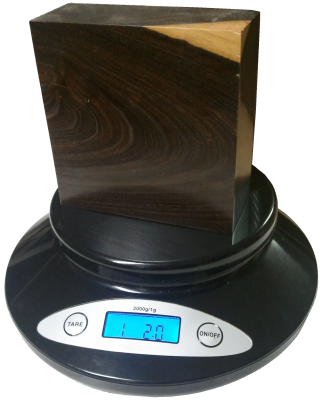
How hard is the wood?
Obviously softwoods will tend to be softer than hardwoods, but try to get a sense of how it compares to other known woods. Density and hardness are closely related, so if the wood is heavy, it will most likely be hard too. If the wood is a part of a finished item that you can’t adequately weigh, you might be able to test the hardness by gouging it in an inconspicuous area. Also, if it is used in a piece of furniture, such as a tabletop, a general idea of its hardness can be assessed by the number and depth of the gouges/dings in the piece given its age and use. A tabletop made of pine will have much deeper dents than a tabletop made of Oak. Additionally, you can always try the “fingernail test” as a rough hardness indicator: find a crisp edge of the wood, and with your fingernail try to push in as hard as you can and see if you’re able to make a dent in the wood.
5. Consider its history.
Many times we forget common sense and logic when attempting to identify wood. If you’ve got a piece of Amish furniture from Pennsylvania, chances are more likely that the wood will be made of something like black walnut or cherry, and not African wenge or jatoba. You might call it “wood profiling,” but sometimes it can pay to be a little prejudiced when it comes to wood identification. Some common-sense questions to ask yourself when trying to identify a piece of wood:
Where did it come from?
Knowing as much as you can about the source of the wood—even the smallest details—can be helpful. If the wood came from a wood pile or a lumber mill where all the pieces were from trees processed locally, then the potential species are immediately limited. If the wood came from a builder of antique furniture, or a boat-builder, or a trim carpenter: each of these occupations will tend to use certain species of woods much more often than others, making a logical guess much simpler.
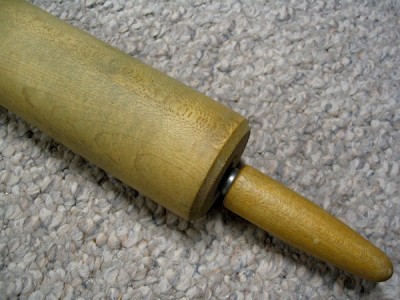
How old is it?
As with the wood’s source, its age will also help in identification purposes. Not only will it help to determine if the wood should have developed a natural patina, but it will also suggest certain species which were more prevalent at different times in history. For instance, many acoustic guitars made before the 1990s have featured Brazilian rosewood backs/sides, yet due to CITES restrictions placed upon that species, East Indian rosewood became a much more common species on newer guitars. (And this is a continuing shift as newer replacements are sought for rosewoods altogether.)
How large is the piece of wood?
Some species of trees are typically very small—some are even considered shrubs—while others get quite large. For instance, if you see a large panel or section of wood that’s entirely black, chances are it’s either painted, dyed, or stained: Gaboon ebony and related species are typically very small and very expensive.
What is the wood’s intended use?
Simply knowing what the wood was intended for—when considered in conjunction with where it came from and how old it is—can give you many clues to help identify it. In some applications, certain wood species are used much more frequently than others, so that you can make an educated guess as to the species of the wood based upon the application where it was used. For instance, in the United States: many older houses with solid hardwood floors have commonly used either red oak or hard maple; many antique furniture pieces have featured quartersawn white oak; many violins have spruce tops; many closet items used aromatic red cedar, and so forth. While it’s not a 100% guarantee, “profiling” the wood in question will help reduce the number of possible suspects, and aid in deducing the correct species.
6. Find the X-Factor.
Sometimes, after all the normal characteristics of a sample have been considered, the identity of the wood in question is still not apparent. In these instances—particularly in situations where a sample has been narrowed down to only a few possible remaining choices—it’s sometimes helpful to bring in specialized tests and other narrower means of identification.
The following techniques and recommendations don’t necessarily have a wide application in initially sorting out wood species and eliminating large swaths of wood species, but will most likely be of use only as a final step in special identification circumstances.
Odor
Believe it or not, freshly machined wood can have a very identifiable scent. When your eyes and hands can’t quite get a definitive answer, sometimes your nose can. Assuming there is no stain, finish, or preservative on or in the wood, quickly sand, saw, or otherwise machine a section of the wood in question, and take a whiff of the aroma.
Although new scents can be very difficult to express in words, many times the scent of an unknown wood may be similar to other known scents. For instance, rosewoods (Dalbergia spp.) are so named for their characteristic odor that is reminiscent of roses. Although difficult to directly communicate, with enough firsthand experience scents can become a memorable and powerful means of wood identification.
Fluorescence
While certain woods can appear basically identical to one another under normal lighting conditions, when exposed to certain wavelengths—such as those found in blacklights—the wood will absorb and emit light in a different (visible) wavelength. This phenomenon is known as fluorescence, and certain woods can be distinguished by the presence or absence of their fluorescent qualities. See the article Fluorescence: A Secret Weapon in Wood Identification for more information.
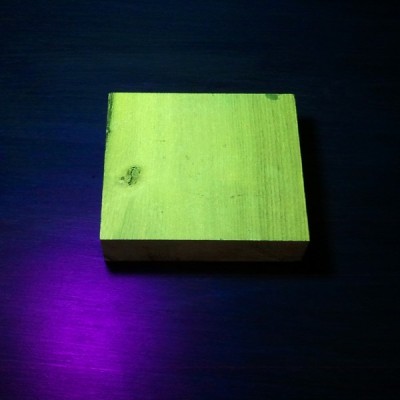
Chemical Testing
There are only a small number of chemical tests regularly used on wood, most of which are very specialized and were developed to help distinguish easily confused species with one another. They work by detecting differences in the composition of heartwood extractives. A chemical substance (called a reagent) is usually dissolved in water and applied to the wood surface: the surface is then observed for any type of chemical reaction (and accompanying color change) that may occur. Two of the most useful are the tests that are meant to separate Red and White Oak, and Red and Hard Maple.
Heartwood Extractives Leachability
Sometimes a wood species will have heartwood extractives that will be readily leachable in water and capable of conspicuously tinting a solution of water a specific color. For instance, the heartwood extractives contained in osage orange (Maclura pomifera) contain a yellowish-brown dye that is soluble in water. (This can sometimes be observed anecdotally when the wood is glued with a water-based adhesive: the glue’s squeeze-out is an unusually vibrant yellow.)
In a simple water extract color test, wood shavings are mixed with water in a vial, test tube, or other suitably small container, and the color of the water is observed after a few minutes. If the heartwood extractives are leachable by water, then a corresponding color change should quickly occur.
In addition to osage orange (Maclura pomifera), merbau (Intsia spp.), and rengas (Gluta spp. and Melanorrhoea spp.) are also noted for their readily leachable heartwood extractives. Because this property is quite uncommon, it can serve to quickly differentiate these woods from other lookalikes.
7. Look at the endgrain.
Perhaps no other technique for accurate identification of wood is as helpful and conclusive as the magnified examination of the endgrain. Frequently, it brings the identification process from a mostly intuitive, unscientific process into a predictable, repeatable, and reliable procedure.
Looking at the endgrain with a magnifier shouldn’t be a mystifying or esoteric art. In many cases, it’s nearly as simple as examining small newsprint under a magnifying glass. There are three components necessary to reap the full benefits contained in the endgrain:
I. A prepared surface.
When working with wood in most capacities, it becomes quickly apparent that endgrain surfaces are not nearly as cooperative or as easily worked as face grain surfaces. However, in this case, it is absolutely critical that a clear and refined endgrain surface is obtained.
For a quick glance of a softwood sample, a very sharp knife or razor blade can be used to take a fresh slice from the endgrain. However, in many denser species, especially in tropical hardwoods, one of the best ways to obtain a clear endgrain view is through diligent sanding. It’s usually best to begin with a relatively smooth saw cut (as from a fine-toothed miter saw blade) and proceed through the grits, starting at around 100, and working up to at least 220 or 320 grit, preferably higher for the cleanest view.
II. The right magnifier.
It need not be expensive, but whatever tool is used to view the endgrain should have adequate magnifying power. In most instances, 10x magnification is ideal, however, anything within the range of 8 to 15x magnification should be suitable for endgrain viewing. (Standard magnifying glasses are typically in the range of 2 to 4x magnification.)
These stronger magnifiers, sometimes called loupes, usually have a smaller viewing area than standard magnifying glasses. Fancier models—with built in lights, or larger viewing surfaces—are available at a premium; but the most basic models are usually only a few dollars.
III. A trained eye.
The third element that constitutes a proper endgrain examination is simply knowing what to look for. In analyzing the patterns, colors, shapes, and spacing of the various anatomical features, there is a veritable storehouse of information within the endgrain—all waiting to be unlocked. Yet, if these elements have not been pointed out and learned, the array of features will simply seem like an unintelligible jumble. The discipline of recognizing anatomical endgrain features is not easily summed up in a few sentences or even a few paragraphs, but it is nonetheless critical to the identification process. To this end, an in-depth look should be given to the various categories, divisions, and elements that constitute endgrain wood identification on the macroscopic level. (In this regard, macroscopic denotes what can be seen with a low-powered, 10x hand lens—without the aid of a microscope—rather than simply what can be seen with the naked eye.) Because the anatomy between softwoods and hardwoods is so divergent, each will be considered and examined separately:Still stumped?
If you have a mysterious piece of wood that you’d like identified, you’ve got a few options for next steps:USDA’s Forest Products Laboratory
You can mail your physical wood samples to the Center for Wood Anatomy Research.
Pros:
- Free
- Professional wood identification
Cons:
- Only available to US citizens
- Slow turnaround times (up to a month or more)
- Limited to three IDs per year
See their Wood ID Factsheet for more info.
Alden Identification Service
You can mail your physical wood samples (even small sections taken from antiques) to Alden Identification Service.
Pros:
- Professional wood identification
- Faster turnaround times (ranging from a few days to a week or two)
Cons:
- Paid service
See their ordering page for more info. (Note that Harry Alden has written several books while at USDA, including both Hardwoods and Softwoods of North America.)
Ask for help online
If the wood ID is merely a curiosity, or non-critical, you can post pictures of the wood in question.
Pros:
- Free
- No need to send physical samples
Cons:
- Greatly limited by the quality of the pictures provided
- Extra work usually required to get adequate clarity in photos
See article of Common US Hardwoods to help find the most commonly used woods.
Get the hard copy
 If you’re interested in getting all that makes The Wood Database unique distilled into a single, real-world resource, there’s the book that’s based on the website—the Amazon.com best-seller, WOOD! Identifying and Using Hundreds of Woods Worldwide. It contains many of the most popular articles found on this website, as well as hundreds of wood profiles—laid out with the same clarity and convenience of the website—packaged in a shop-friendly hardcover book.
If you’re interested in getting all that makes The Wood Database unique distilled into a single, real-world resource, there’s the book that’s based on the website—the Amazon.com best-seller, WOOD! Identifying and Using Hundreds of Woods Worldwide. It contains many of the most popular articles found on this website, as well as hundreds of wood profiles—laid out with the same clarity and convenience of the website—packaged in a shop-friendly hardcover book. 





Why I will no longer be replying to every wood ID request I’ve replied to literally thousands of wood ID requests on this site over the past 13+ years, but as the site’s popularity has grown, so has the time demands for ID on a daily basis. (Contrary to what some may seem to think, I am not some all-knowing wood wizard that can instantly ID your wood. It can actually take me a long time to sift through a lot of different resources.) Over the past few years, my backlog of pending wood species to be added to the… Read more »
Hello. I have a burl that I got from a store 10+ years ago. There was no identification with it. It does have “MA 8.5” written on one face. I am pretty sure it is NOT MAple. I will try attaching some images. It is quite hard and heavy. Some of the pictures are raw wood, sanded, and some have light coat of semi-gloss Deft lacquer. I see only 3 pics are allowed. I have more if needed. Thanks.
I agree it does not look like maple. To me, it looks most like an Australian mallee species. Perhaps the most precise ID would simply to call it a Eucalyptus burl.
Hi Eric,
Can you tell what type of wood this table is. Bought at thrift store on west coast and is very heavy.
Looks like a type of one of the heavier/harder softwoods in the US, possibly douglas fir or a species of southern yellow pine.
Ok thank you! It is very hard also ..can’t get finger nail into it at all.
I guess I can sort of make out some resin canals in that picture, but hard to see them very clearly. Unfortunately, both douglas fir and hard pines both have resin canals, so this doens’t resolve too much other than to confirm it is a softwood (i.e., a conifer).
Hi Eric, I am refinishing an antique side table and trying to identify the wood. Seems like walnut or cherry but perhaps mahogany. Table is heavy; it had a dark stain on it which I am still working to remove on the top. Wood seems to have a red hue to it on drawers. Attached is top and a drawer. Thanks for any insights.
That second picture is a textbook example of the semi-ring porous pattern found in black walnut.
Hello Eric,
Got the Crown molding from grandfather after years of him saving in the garage.
Wanted to know what type of wood material it is, looks like pine but If you could confirm it would be greatly appreciated. Some crown in 10ft 121″ pieces, 41/4″ wide, some Knotts in the wood. Your knowledge is greatly appreciated.
Thank you for your time, Take care.
Sorry, I can’t tell from the picture. Is it possible to get a closeup picture of the endgrain that’s been finely sanded? Or a closer picture of the grain? Thanks.
I am looking for help in identifying this wood.
Doesn’t look immediately recognizable as anything common in North America. Can you get a closer picture of the wood grain? Also, where in the world are you located?
Some background, this is in a century old house in Pasadena, Ca. The wood is used in this cabinet as well as extensively as moldings and wainscoting in the dining room, its has an orange-y tone to it. I will get a closer image of the grain.
Thanks, closer images will be helpful. Have you sanded the raw wood at all? Is there a noticeable scent when doing so?
Here is a sanded sample. When “wet” orange color is predominant.
Unfortunately, I didn’t get the chance to smell this when it was being sanded.
Sorry, can you try reattaching your picture, it didn’t come through.
technical trouble!
Could this be plain sawn KOA?
We determined that this piece was actually American Red Gum a species of liquidamber from the Southern states.
Removing a mismatched stain and thought I’d better identify the wood before staining again. I would love your help! Thanks!
I think the residual stain in the growth rings is throwing me off a bit, but to me it looks a lot like cherry. You may want to use a gel stain with cherry. You can use a slightly lighter color and do multiple applications (gradually darkening as coats build up) to sneak up on the right color.
Hi Eric, I sanded down the wood on a 65+ year old dresser that I got in Southern California. Before it was sanded, you said it may have been ash wood. Is that still what you think it is? Sorry about the shade.
Hard to tell from that distance, but it looks like a ring porous hardwood. Oak and ash would be two leading contenders.
Hi Eric,
Im renovating an old home (built in 1925). I’m trying to determine what type of wood is being used for wrapping the arch opening. I added a second arch opening and would like to use the same type of wood.
Thanks.
Jeff
Hard to tell from the pic, but it resembles oak to me. Looks like there was some sort of reaction between the stain and the finish, as it looks like the finish bubbled up. Existing wood might be a good candidate to refinish too!
Hi Eric,
you are correct about the finish. Most of the trim has the same issue. I’m planning on sanding and refinishing the trim. Is there a better way to identify the wood type? Would a better pic work?
thank you
Jeff
Jeff, ideally raw unstained wood is best to photograph. Also getting a good image of the endgrain (sanded clean) is best, but may not be feasible in your situation.
Hi Eric. Sorry to bother you again. Last time I promise. Could you please identify these 3 peices of wood please? Many thanks.
Hard to tell since the endgrain is still very rough — I would need to see a much cleaner shot of the endgrain to get a better idea. The second one that’s darkest may be a type of striped ebony.
Hi Eric. As requested
Thanks Ralph, it is still too coarse to tell. I would need to see endgrain finely sanded in order to make out the smaller anatomical elements.
Darker peice.
Hmm, after seeing the endgrain, I retract my guess of striped ebony. The pores look too numerous for Diospyros.
If you ever strip the wax off or cross cur this piece, getting a finely sanded pic of the endgrain, particularly the lighter colored part, could be of some help in ID.
Thanks Eric. When I get round to turning something with it, I’ll get some better grain photos.
I am trying to salvage this very old door; I have citrus-stripped it twice, cleaned it once with mineral spirits, any idea what kind of wood this is?
Hmm, it doesn’t look like any typical wood in the United States — where are you located? Is it possible to be a closeup shot of the endgrain?
I’m in Minnesota but this door came from a series of salvage/reclamation places, so I have no idea of the origin. The hardware on the door was a lock & solid bronze knobs made in 1900 in a foundry in New Britain Connecticut.
I’ll get a shot of the end grain, I’m thinking I need to sand it down a bit on the ends (because they are pretty destroyed) and that may help tell me if it’s a veneer over another piece of wood or what.
Hi Eric-
Looking to stain the wood in my kitchen darker. Thought I was doing it correctly but now am thinking I maybe be wrong. Any help? The house was built in 1920.
Hard to say for sure as it doesn’t seem to be a natural wood color. Overall, it superficially resembles cherry, but that may simply be due to the stain color. Once a wood is stained and finished, you can’t really properly re-stain it without completely stripping off the existing finish (and usually the old stain too).
What makes you say that you are doing anything incorrectly?
This is the wood in the house I am staying in. I was told it’s oak.
Hmm, hard to tell from that distance, but I can definitely see a resemblance, especially in the floor planks in the second picture.
Thank you!
We have a very dark stained mantel, I’ve been sanding it back so I can restain it much lighter but need to know what it is to make sure I use the right products
That certainly bears the mark of genuine mahogany to my eye. Looks like a nice piece, and should clean up and stain very nicely if sanded properly.
Hi. I was given this matched pair of mid century chairs. They have been outside for over a year here in Calgary. One seems to be raw now and I think a type of teak and the other though structurally, exactly the same, is light and have some kind of finish on part of it. When I sand, the light one stays light and in places a bit rosy colored. The dark one is rich and dark and when wet even darker. Two cuts or types of teak like wood. They are not exceptionally heavy and with the fingernail test… Read more »
I don’t think either of them are teak. The darker one looks a bit like meranti to me, sometimes marketed as Phillipine mahogany, but I can’t say for sure from the pic. The lighter one, your close up picture is not in focus. Please check to make sure pictures are in focus and I can give a better idea on ID.
Hi Eric and thank you so much. Attached are some more clear close up photos. As I mentioned, the chairs are identical in every way. It just seems they are different woods but they may not be. I’ll value your opinion. The first 3 are of the more blonde chair and the last two are close ups of the darker chair that has no finish left on it except a
The photos didn’t post. Here are 3 of the lighter chair.
This looks like something that’s less rot resistant, as it appears that the top of the chair is starting to get weathered and discolored a bit. Possibly something like maple or birch? Can’t tell for certain without a very clear image of the endgrain.
Thank you Eric. Yes, the chair is getting weathered and has some dark streaks in the grain that look like mold or mildew.
And three of the darker chair that seems to have no finish left on it. You can see in the first photos that it looks darker where the cushion sat when the chair was left outside. My neighbours had these sitting behind their garage and I asked for them.
It appears to be different than the lighter chair. At the very least, it bears a superficial resemblance to some type of mahogany. https://www.wood-database.com/wood-articles/mahogany-mixups-the-lowdown/
Thank you so much Eric for all you do. I agree and wondered upon closer inspection if it was a type of mahogany. How odd that two identical chairs should be such different woods.
I have engineered flooring with a very dark finish on what looks like much lighter wood. Do you know what the wood could actually be? Would like to try and get it refinished
Looks like oak
This is a butcher block type table bought in Germany in early 2000’s. I’d love to refinish it.
Looks like a type of hard pine. I can see the resin canals pretty clearly, which is most indicative of hard pines. https://www.wood-database.com/wood-articles/pine-wood-an-overall-guide/
Thanks so much!
I got this piece of wood at a craft store I want to make a Cutting board out of it but I’m not sure if it’s hard enough to do that or what type of wood it is can anyone please help?
Not sure from the picture, though I seem to remember seeing slabs of craft wood being sold before which I believe were birch. It may be borderline too soft, but perhaps worth a shot if it feels decently heavy. At least it appears the pores aren’t too large, which can be a problem in other hardwoods like oak or ash, where the pore cavities can trap bacteria.
Can you help identify this wood so I can have more cabinets made
Hi, I picked up some bits of this wood from a local timber yard, in North Queensland, Australia. I haven’t been able to identify what it is, as I’m new to woodworking, and the yard owner wasn’t sure, as he had just bought the yard and was still figuring out what was there. I’ve done some work on a bit, and it has an almost shimmering effect in the right light (couldn’t get it on camera), it’s quite hard and has a distinct scent, especially when I plane it. The bits I got still had a much lighter sapwood still… Read more »
Looks like laburnum. This is a small tree though, so the planks you have would have to have come from a large specimen. If it is laburnum, take great care maching and handling it as all parts of the tree are poisonous.
Having looked at a few pictures on google, I think you may be right. Good thing I hadn’t gotten around to working it too heavily yet. The only thing that sounds off is that I saw it described as having no characteristic odour, when the bits I’ve been working with definitely have a very specific, pleasant scent when worked. Either way, I’ll take more care with it from now on. Thanks.
I’m trying to identify some veneer from a mid-century looking piece. Photos include one with finish on, one of the inner side which does not look finished and one with finish scraped off.
Hello! I think this is Douglas Fir but am not 100% certain – would love an expert’s confirmation! Thank you!
I can’t give a 100% confirmation with those pictures. I agree it does look like Douglas fir though.
Thank you Eric!
Help please, looking to buy a house that has this wood EVERYWHERE, doors, baseboards, door jams etc, love the wood not the color. Can you tell what wood it is and can i restain it a different color?
Looks like a ring porous hardwood, possibly oak? It will be a major job to properly restain the wood because you’d have to strip the finish off, potentially sand off the stained wood, and then restain raw wood. A lot of the designs look fairly ornate, so it’d be a tough time doing all that properly. I shortcut method would be to use a toner product such as minwax’s polyshades, which is basically a tinted polyurethane that you can apply over top the existing stain — this is assuming you want a darker color.
was used for a humidor, was told it was spanish red cedar but I’m questioning the authenticity of that. Picture is all i have to go off of.
I’ve never heard of the name “Spanish red cedar” with both Spanish and red in the name. It’s usually either or.
In this case, it appears to be eastern red cedar https://www.wood-database.com/aromatic-red-cedar/
I was wondering if you can confirm what type of wood this is. I used it as a test piece for my home built CNC but I have no idea what the wood is. I thought it might be ambrosia maple. I received the wood from a local pipe supplier as scrap lumber from their shipments. I am in Canada (Saskatchewan).
Yeah, it looks like ambrosia maple. Probably Acer rubrum.
Hi. I live in Canada (Saskatchewan). However I got some dunage hardwood from a company the brings in pipes. So I don’t know where this wood would have come from. Most of the wood has been maple and white oak however I just milled some of the boards and this wood seems different. The reddish hue is throwing me off on what it might be. I though maybe cherry. Hopefully you can assist.
I agree it doesn’t look like maple or oak. Hard to tell without a clear endgrain shot. If possible, try to get in better light and get a pic as close are the camera/phone will allow and still be in focus.
Hopefully these ones are better.
Slightly better, but I still can’t make out enough detail. I can’t even tell if it is a hardwood or softwood from those pictures. Not sure if it’s the phone used, or if it’s out of focus, but it looks like the camera is compensating for low light levels. Basically all the details in the image are turning to mush. This is one instance where the devil is in the details.
You’re a good egg, Eric Meier! You have provided more than 2,000 people with answers to their most challenging wood-related questions!! To me, that’s an amazing feat. Hoping you can help me as well. Riverside, CA. Home built in 1956. Part of the “Sungold” series of tract homes. Many of which are right here in Riverside where just last week, the thermometer hit a staggering 117°! Miserable as Hell! Toss in a Global Pandemic, the biggest and most catastrophic and costly fire season on record. Just glad to be here. This is a drawer from the kitchen. From stripping via… Read more »
Well, you’ve got me stumped so far. Is it possible to clean up the endgrain on one of the panels of wood and get a good closeup picture of the end? That might shed more light.
Hi, an 1870’s American clock case I’m guessing walnut? Heavily stained unfortunately. I cleaned the spot of shellac for a cleare grain view. Not positive of the crown mounding though.
I’d say the leading contender would be mahogany. Hard to say for sure without seeing endgrain.
Great article! I’m a newbie and am trying to educate myself a bit more on wood in general. What do you think this is? It’s the top of a piece I’m in the process of refinishing.
Looks like a ring porous hardwood. Possibly oak? Can’t tell from that distance.
Any idea what type of wood this is? Looking to make some fixes to a water stain!
Looks like oak. You’ll want to also try to match the stain color as closely as possible to get the best color match.
hi
could you please identify this. I have four pieces and each is around 59.2 lbs/ cubic foot
What area of the world are you located?
im in North Vietnam
I don’t know, sorry! You might try keying in some characteristics of the wood in NCSU’s Inside Wood database and see what comes up if you recognize anything. https://insidewood.lib.ncsu.edu/menu/type/modern?14 Note that the most unique feature of your wood is that vessels are arranged in a dendritic pattern, so be sure to put that into the system. Good luck!
Hi Eric and thank you for all this information. I am trying to identify the wood type of my wainscoting from my home in Pennsylvania. Any ideas? It is an older house built in 1860s, though I can’t be sure how old the wood is.
Hi.
Found this wood in my late fathers workshop. The white wood is very hard and heavy. Looks like sycamore and maple. Its just too hard to be either of those I think. The two peices are the same wood. Just one half is turned. No distinct smell to the wood. Really bad end grain tear out on the bowl.
I presume Eric will reply so thank you very much Eric.
Yes, the frequency and size of the rays very much looks like a Platanus species like sycamore. Is it possible to get a definite weight on the raw sample to see what the density really is?
Hi Eric.
Apologies for the European measurement, but the density is 853kg/m3. Which isn’t sycamore or hard maple.
I agree, assuming that the wood is fully dried, that’s too heavy for sycamore. But the rays are very distinct. I’m guessing that it may be something in the Proteaceae family, which includes most species of lacewood. What region or area did the wood come from?
Hi Eric.
I found it at the back of my fathers workshop in West Wales, so its probably been in there for about 30 years. He was a cabinet maker so he has lots of peices of hardwood scattered around and could be anything. Its very dry.
Could it be satinwood or yellowheart? Were they readily available decades ago?
Your doing a very good job here Eric. Well done.
Sorry, the weight of the wood is most puzzling. It’s not satinwood or yellowheart. The rays are very distinct, it looks like a Platanus species to me. I did find a reference to a piece of London plane that had a basic SG of .60, which would be be a dry weight of around 800 kg/m3, so not too far off what you’ve got. Based on location, that’d be my vote with given information.
Thank you very much Eric. Your time is much appreciated.
Hi! Just purchased this old trestle table and was told (not with much confidence though) that it’s from the 1940s. I’m thinking maybe alder but would love to know your opinion. Photos are once the finish was stripped.
To me, those streaks look like large resin canals, perhaps with residual stain embedded in them. Resin canals point strongly to hard pine. https://www.wood-database.com/wood-articles/pine-wood-an-overall-guide/
Hi Eric,
My boss bought some property and it had huge beams of this wood. It’s very hard and dense and it kind of stinks. Any ideas?
What part of the world are you in?
Hi Eric! I can’t find anyone who can tell me what kind of wood this antique bed is made of. Can you help? And, no, the grain is not painted on. Thanks!
Possibly ash? Hard to tell because it is stained and not a natural wood color. Would need a closer pic of the grain.
Hello,
what kind of wood is this?
It’s so darkly stained I can’t tell from that picture.
Hi Eric, I have a home in Buffalo NY built in 1911. The sheathing and framing were done in a rough cut lumber that I assume is a type of spf but want to know if it has any treatment to it, since it has a red tint to it and I cannot seem to match it to anything. There is scrap wood around and if it has any type of treatment I won’t use it, if it’s fine I’d love to use it. It seems like a soft wood but has more toughness and “meat” than any softs I… Read more »
Pictures didn’t come through. Please reattach.
The last pic is the best shot of the end grain I could get.
Hmm, yes it does look like it’d be a tough one to color match. It appears to be a softwood, but I’m not sure it’s stained because softwoods generally absorb more stain in the wider latewood sections and leave the growth rings a lighter color, but this wood has darker earlywood sections, which would indicate it is not stained. It may just be a dark patina over the years, or a wood naturally darker like cedar. The toughness of the wood is simply due to the age, as 100 years ago trees were larger and had much tighter growth rings… Read more »
what wood would you say this is? I thought Acacia but someone else said Dalbergia Sissoo?
Hello Eric, could you please help identify these two types of veneer. The lighter one has very ‘orange-y’ tint to it which I’d like to sand down and make it look more natural. The middle is a darker one which I think I will need to replace as the knots (the dot like looking at the bottom) are peeling off. I’m in the UK and I’ve seen lots of older furniture of this type so must have been a trend at some point. I’d greatly appreciate your help. Cora
Looks like a very nice piece that I would get professionally appraised.
Hi Eric, I hope you can help ID this wood I got from a local tree trimmer. Location is Spring, Texas, just north of Houston. Bark is about 1/8 inch thick. Sapwood is 1/2 inch thick, and is essentially white. Heartwood is light brown to olive green hued with hints of dark mustard color. I am uploading a photomicrograph of the endgrain (not sure if image actually uploaded). Thank you, Larry
Please attach pic. Also an overall picture of the face grain would help too.
please help me identify this piece of wood ,it is stumping me ,i live and acquired this wood in florida it was already milled ,i dont remember where i got it, it was in with my other woods from years ago when i was working with wood alot. it is hard and dense ,i cant make out the odor i think it might be in the hickory family , thanks in advance, Sincerely , Norman
Looks like white oak to me
Please identify if possible. Possibly from India. Thank you
My first guess would be mango, or possibly rubber wood.
Ok,ty. It’s a hard wood if that helps. Did the fingernail test.
Hello,
My previous comment did not attach pic
Need help with identifying all 3 wood and colors
I have refinish them
Hello,
I have to refinish my furniture but I don’t know why color/types could you help
Hi Eric. could you identify these for me? I got then in China, Yunnan province
No idea, sorry. I don’t know much about Chinese woods.
Ok thanks. how about these pieces?
Third pic might be pine as I can see what appears to be resin canals. Not sure on the other two.
Wood being orthotropic, could you clarify how Wood Database mechanical properties bare derived? For example, from which set of axes is the modulus of elasticity derived?
If you click on the strength property in question on each wood profile page, you’ll be taken to an explanation of that property. But MOE and MOR are both from the longitudinal axis.
Hi Eric,
Thanks for getting back. I’ll explain the source of my question. The book published by the US Department of Agriculture, “Wood Handbook, Wood as an Engineering Material” publishes the value of the Modulus of Elasticity for Black Walnut as 11,600 MPa, which agrees most perfectly with “The Wood Database” value of 11.59 GPa. However, at the bottom of 5-8 (Chapter 5, pg. 8), footnote “c” states, “Modulus of elasticity measured from a simply supported, center-loaded beam, on a span depth ratio of 14/1.” Center loaded, that is to say, a radial load, and not longitudinal. Confusing.
Yes, the load is coming radially, but it is measuring longitudinal strength.
Ok, my turn! Was given several peices of wood that came from central and south america 20+ years ago. I think the bulk of it is brazilian cherry. There are a couple darker peices as well and at least one snakewood peice. First two pics guessing are the brazilian cherry. Not sure on third pic. Will add end grain in next post.
I agree the endgrain shot looks like jatoba, aka Brazilian cherry. Not sure on the reddish piece. Endgrain shot would be helpful.
Here is an end grain of the second. Almost looks like purple heart… Wondering if they made a mistake on this one’s origin.
It does resemble purpleheart, but I’ve never seen a piece of purpleheart that was the reddish color in your previous picture. It is more than likely a piece from south or central america as stated, just one that I am not familiar with.
I was recently given this unit, which I had just presumed was pine but after stripping it off I am not so sure. Could you please tell me what it is?
Definitely not pine. Looks like a ring porous hardwood, but not any of the usual suspects like oak. What region of the world did the wood come from, and can you get a closer picture of the endgrain?
Thanks for your reply Eric, the type of wood it is has totally baffled us! I’ve attached another picture as requested and the piece was purchased from an Eastern European lady in Dubai, so I’m afraid that probably isn’t much help as furniture from every corner of the world here!
Actually, that location helps a lot. Most of the people commenting on here are from North America, so it is VERY relevant that you are from the other side of the world.
It looks like teak.
Thank you so much!!! ?
This peice of wood came from my dad. I remember him telling me about it and it was from a tree you could no longer harvest. I cant remember the name and cant be sure this is it but it weighs a ton this peice weighs about 15 pounds. Im afraid to do much to it in case it is a rare find
It looks like a diffuse porous tropical hardwood. Do you know where the tree was harvested from? Does it have a noticeable odor when sanding or cutting it?
Unfortunately i have no way of knowing where it was harvested. I did sand it and there was no real distinctive smell to it. Just smelled like sanded wood.
Hello Eric, I bought a house that had a few rough sawn boards in the garage. Any idea what kind of wood this might be?
Looks like a diffuse porous hardwood. Hard to say without a clear closeup view of the endgrain.